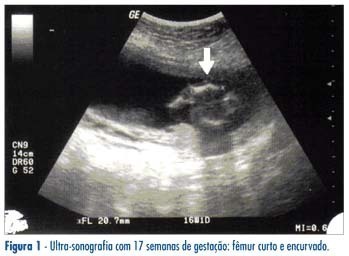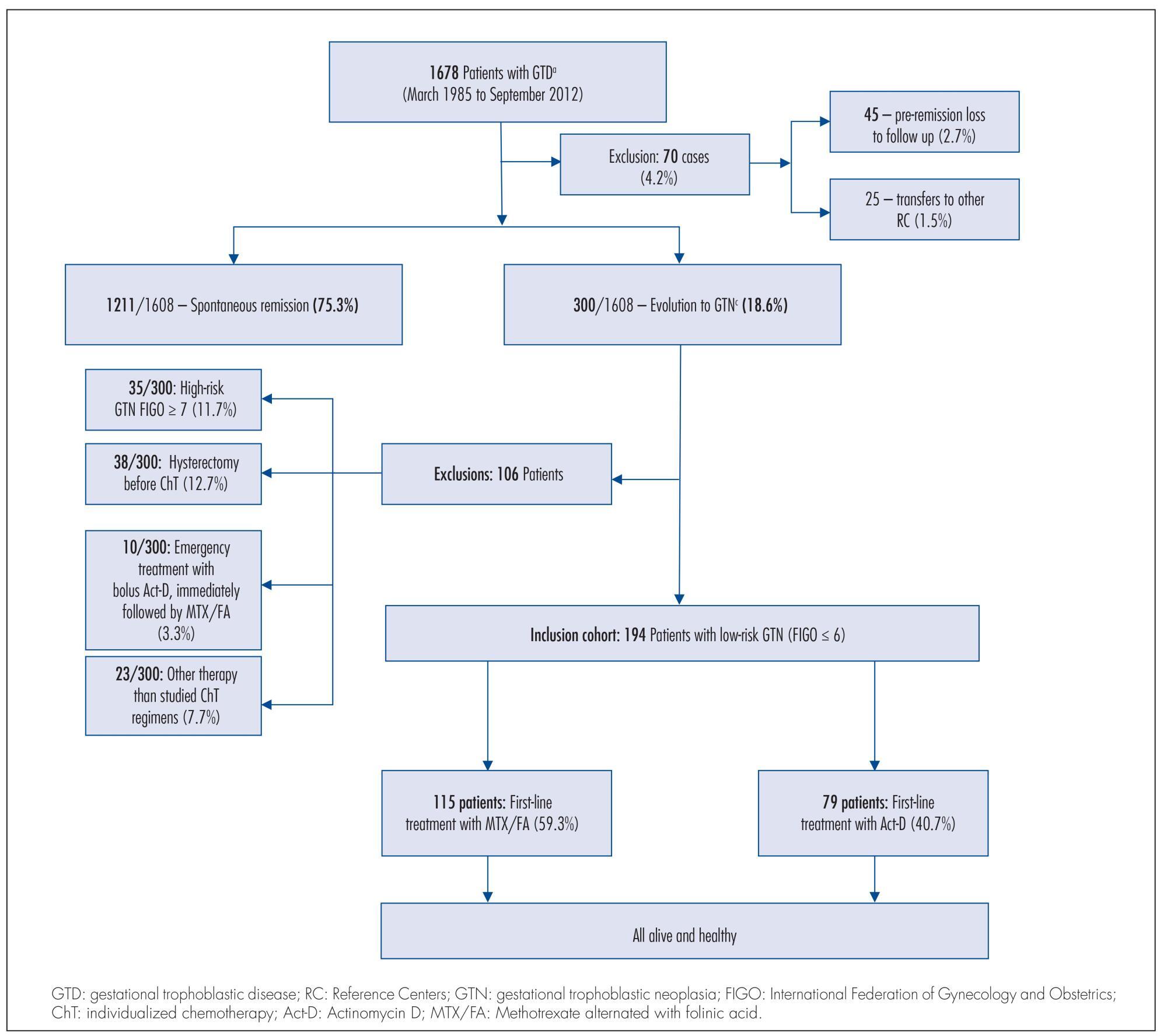Summary
Revista Brasileira de Ginecologia e Obstetrícia. 2000;22(5):257-263
DOI 10.1590/S0100-72032000000500002
Purpose: to evaluate the evolution of gestation, metabolic control and perinatal outcome of pregestational diabetic patients and to perform a comparative study of the results of patients with insulin-dependent diabetes (type I) and non-insulin-dependent diabetes (type II). Methods: retrospective analysis of 57 pregestational diabetic woman charts who began a prenatal follow-up in the Service of Maternofetal Medicine of the Maternidade-Escola Assis Chateaubriand of the Universidade Federal do Ceará, in the period from January 1995 to December 1998. The 57 pregnant women included in the study were divided into groups: the first, composed of 28 patients with insulin-dependent diabetes (type I), and the second with 29 pregnant women with non-insulin-dependent diabetes (type II), controlled with diet or with oral hypoglycemics before pregnancy. Results: there was no statistically significant difference between the two groups in relation to the need of hospitalization for glycemia control (39.2% x 27.5%) and maternal complications, such as: chronic arterial hypertension (14.2% x 27.5%), pregnancy-induced hypertension (14.2% x 17.2%), premature rupture of membranes (3.5% x 10.3%), urinary tract infection (10.7% x 6.8%), and preterm labor (3.5% x 6.8%). However, episodes of maternal hypoglycemia were more frequent among insulin-dependent patients (35.7% x 3.4%). The perinatal results were similar. We observed a great number of congenital anomalies and increased perinatal morbidity and mortality. Conclusion: there was no difference in the incidence of obstetric and clinical complications between insulin-dependent and non-insulin-dependent patients, except for maternal hypoglycemia.
Summary
Revista Brasileira de Ginecologia e Obstetrícia. 2004;26(3):257-257
Summary
Revista Brasileira de Ginecologia e Obstetrícia. 2005;27(5):257-262
DOI 10.1590/S0100-72032005000500005
PURPOSE: to verify if the high frequency of vaginal intercourses and the use of doushing interferes with vaginal microbiota. METHODS: ninety-seven women were examined at a health center located in the prostitution area of the city of Campinas, and evaluated in a prospective cross-sectional study. Anamnesis determined the frequency of vaginal intercourse and the use of douching in the 44 sex professionals and 53 non-professionals studied. The vaginal content was collected with a sterile Dacron swab, from the right vaginal wall, and placed on to two glass laminas. The vaginal microbiota smear stained by the Gram technique was studied with light microcopy using immersion lens and the data were analyzed. The sex professionals and non-professionals presented mean age of 24.9±6.4 and 31.5±9.7, habit of smoking in 52.2 and 24.5%, the use of vaginal lubricants in 56.8 and 0%, and the use of condoms in 100 and 41.5% of the cases, respectively. RESULTS: only 1.8% of the women in the control group had seven or more sexual intercourses per week, contrasting evidently with the sex professionals (97.7%). There were no significant differences regarding race, educational level and number of pregnancies. Bacterial vaginosis and abnormal vaginal flora were more observed in sex professionals (p=0.02 and 0.001) and were associated with the high frequency (seven times or more) of weekly vaginal intercourses (p=0.04 and 0.001). Cytolytic vaginosis was more related to non-professionals (p=0.04) and to a lower frequency of sexual intercourses (p=0.04). The use of doushing was more common in the sex professionals (p=0.002). However, this practice was not associated either with the vaginal microbiota problems or with the presence of vulvovaginitis. CONCLUSIONS: sex professionals with seven or more sexual intercourses per week presented a higher frequency of bacterial vaginosis and abnormal vaginal flora. The doushing habit did not interfere with the vaginal environment ecosystem of the studied women.
Summary
Revista Brasileira de Ginecologia e Obstetrícia. 2010;32(6):257-259
Summary
Revista Brasileira de Ginecologia e Obstetrícia. 2008;30(5):257-260
DOI 10.1590/S0100-72032008000500008
Camptomelic dysplasia belongs to a heterogeneous and rare group of lethal skeletal dysplasias, characterized by abnormal development of bones and cartilages. It is caused by a mutation in gene Sox9 (SRY-like HMG [high-mobility group] BOX 9) of chromosome 17 and it is transmitted as an autosomal dominant trait. Its main characteristics are the shortening and bowing of the long bones, principally the lower limbs. It is also associated with other severe skeletal and extraskeletal malformations. Karyotype study may reveal sex reversal. The majority of carriers die during the fetal and early neonatal periods. Ultrasound is essential to elucidate a prenatal diagnosis.

Summary
Revista Brasileira de Ginecologia e Obstetrícia. 2011;33(9):258-263
DOI 10.1590/S0100-72032011000900007
PURPOSE: To evaluate the coverage of Pap smear cytology at Basic Family Health Units (BFHU) and to describe the characteristics of non-performance of this test in the last three years. METHODS: A cross-sectional study was conducted in Rio Grande (RS), Brazil, in areas covered by the Family Health Teams Family (FHT). The interviews were conducted by students participating in the Health-PET, at women’s home. Crude analysis was performed using SPSS software to calculate prevalence ratio, 95% confidence intervals and p value. Multivariate analysis was performed by Poisson regression using Stata 9.0 software, which were included the variables with p value of up to 0.20 in the crude analysis. At the first level, the variables were age, having a partner, and literacy. At the second level, the variables were number of visits and offer of a Pap smear. RESULTS: The prevalence of Pap cytology performed 36 months ago or less was 66.3%. In adjusted analysis, women aged 19 years or less (p<0.001), without a partner (p<0.001), illiterate (p= 0.01), who had never consulted at the basic unit (p=0.02) and who had not been offered the examination during the visit (p=0.006), were more likely not to have had a cytopathology exam in the last 36 months. CONCLUSION: The local health proved to be ineffective and inequitable. Ineffective because it covers fewer women than indicated by the World Health Organization and uneven because access to this test varied according to some characteristics of the users.
Summary
Revista Brasileira de Ginecologia e Obstetrícia. 2017;39(6):258-264
In the pregnancy-puerperal cycle, women may develop complications that require admission to the Intensive Care Unit (ICU). Thus, special attention to pharmacotherapy is necessary, particularly to potential drug interactions (PDIs) and to the effect of the drugs on the fetus and newborn.
The aim of this study was to determine the profile of PDIs and the potential risk of drugs used during pregnancy and breastfeeding among patients admitted to the ICU.
We conducted an observational, cross-sectional and prospective study, including pregnant and breastfeeding women admitted to the ICU at the Women’s Hospital of a university in the city of Campinas, Brazil, for one year. Online databases were used to identify and classify the PDIs and the potential risk of the drugs used during pregnancy and breastfeeding.
We evaluated 305 prescriptions of 58 women, 31 pregnant and 27 breastfeeding, and 284 (91%) prescriptions presented PDIs. A total of 175 different combinations of PDIs were identified in the prescriptions, and adverse effects caused by the simultaneous use of drugs were not actually observed in the clinical practice. A total of 26 (1.4%) PDIs were classified as contraindicated. We identified 15 (13.8%) drugs prescribed with risk D, and 2 (1.8%) with risk X for pregnant women, as well as 4 (4.9%) drugs prescribed with high risk for breastfeeding women.
This study demonstrates that there is a high incidence of PDIs in prescriptions. Most drugs used by pregnant and breastfeeding women at the ICU did not present serious risks to their fetus and newborns, but sometimes drugs with risk D or X are necessary in the course of the treatment.
Summary
Revista Brasileira de Ginecologia e Obstetrícia. 2015;37(6):258-265
DOI 10.1590/SO100-720320150005366
To compare two single-agent chemotherapy (ChT) regimens evaluating, in first-line treatment, response and side effects and, in final single-agent treatment, the outcomes, among Brazilian patients with low-risk gestational trophoblastic neoplasia (GTN), according to International Federation of Gynecology and Obstetrics (FIGO) 2002.
Retrospective analysis of two concurrent cohorts with 194 low-risk GTN patients: from 1992 to 2012, as first-line treatment, 115 patients received 4 intramuscular doses of methotrexate alternated with 4 oral doses of folinic acid (MTX/FA) repetead every 14 days and, since 1996, 79 patients received an endovenous bolus-dose of actinomycin D (Act-D), biweekly. At GTN diagnosis, patient opinion was taken into consideration when defining the initial single-agent ChT regimen, and when there was resistance or toxicity to one regimen, the other drug was used preferentially. This study was approved by the Irmandade da Santa Casa de Misericórdia de Porto Alegre Ethical Committee.
Both groups were clinically similar (p>0.05). In first-line treatments, frequency of complete response was similar (75.7% with MTX/FA and 67.1% with bolus Act-D); the number of ChT courses -median 3 (range: 1-10) with MTX/FA and 2 (range: 1-6) with bolus Act-D - and the time to remission -median 9 weeks (range: 2-16) with MTX/FA and 10 weeks (range: 2-16) with bolus Act-D) - were not different between the groups. In both groups, first-line side effects frequency were high but intensity was low; stomatitis was higher with MTX/FA (p<0.01) and nausea and vomit with Act-D (p<0.01). Final single-agent ChT responses were high in both groups (94.8% with MTX/FA and 83.5% with bolus Act-D; p<0.01) and 13% higher in the group initially treated with MTX/FA. Rates of hysterectomy and of GTN recurrence were low and similar. No patient died due to GTN.
The two regimens had similar first-line ChT response. Final single-agent response rates were high and similar in both groups but the final single-agent remission rate was higher in the MTX/FA group.
